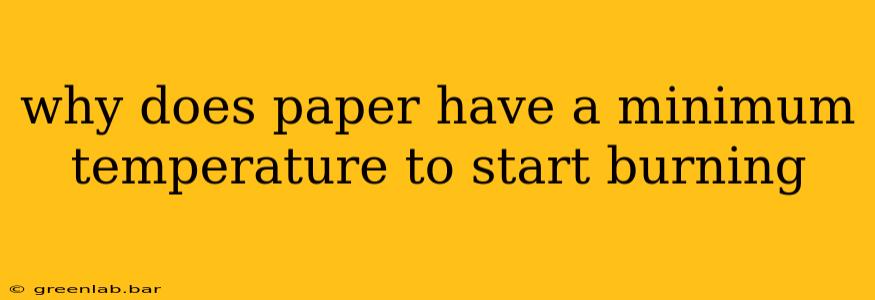Paper, like all materials, requires a specific minimum temperature to ignite and sustain combustion. This isn't some arbitrary figure; it's a consequence of the complex chemical and physical processes involved in burning. Understanding this minimum temperature, often referred to as the ignition temperature, requires delving into the nature of paper itself and the combustion process.
The Chemistry of Combustion: Why Paper Needs Heat
Paper is primarily composed of cellulose, a complex carbohydrate made up of long chains of glucose molecules. When you heat paper, you're adding energy to these molecular bonds. This added energy causes the molecules to vibrate more vigorously. However, simply increasing the vibrational energy isn't enough to start a fire. A crucial threshold must be reached before combustion can begin.
This threshold is the activation energy. This energy is the minimum amount required to break the chemical bonds within the cellulose molecules, initiating a chain reaction that leads to combustion. Once this activation energy is overcome, the cellulose begins to decompose, releasing volatile gases. These gases then react with oxygen in the air, releasing heat and light in the process we recognize as burning. This exothermic reaction produces enough heat to sustain the decomposition and further the chain reaction, as long as enough oxygen is present.
Factors Affecting Paper's Ignition Temperature
The exact ignition temperature of paper isn't a fixed number. It varies depending on several factors:
-
Paper Composition: The type of paper—whether it's newspaper, printer paper, or cardboard—influences its ignition temperature. The presence of additives like fillers, coatings, and sizing agents can alter the heat needed for ignition. For instance, paper treated with flame retardants will have a significantly higher ignition temperature.
-
Surface Area: A larger surface area exposed to the heat source will ignite more quickly than a smaller one. A crumpled piece of paper ignites faster than a flat sheet because the increased surface area allows for more efficient heat transfer.
-
Oxygen Availability: Sufficient oxygen is crucial for combustion. In an oxygen-deficient environment, the ignition temperature will be higher, or combustion may not occur at all.
-
Heat Source: The rate at which heat is applied significantly impacts ignition. A slow, gentle heat source may not reach the ignition temperature even if the temperature eventually surpasses the minimum. A quick, intense heat source, such as a flame, dramatically increases the chance of ignition.
-
Moisture Content: Wet paper requires more energy to evaporate the water before the cellulose can reach its ignition temperature. This explains why damp wood is more difficult to ignite than dry wood.
The Role of Pyrolysis in Paper Combustion
Before actual combustion occurs, paper undergoes a process called pyrolysis. This is the thermal decomposition of cellulose in the absence of oxygen. Pyrolysis produces various combustible gases, such as carbon monoxide and methane. These gases are then readily available to react with oxygen when it's present, significantly lowering the energy required for the overall combustion process.
Conclusion: It's a Complex Process
In summary, paper's minimum burning temperature is determined by the interplay of chemical bonds within its cellulose structure, the activation energy needed to initiate combustion, and several external factors. Understanding this complex interaction highlights why simply reaching a certain temperature isn't enough; the rate of heat transfer, oxygen availability, and paper composition all play critical roles in determining whether and how quickly paper will ignite.

